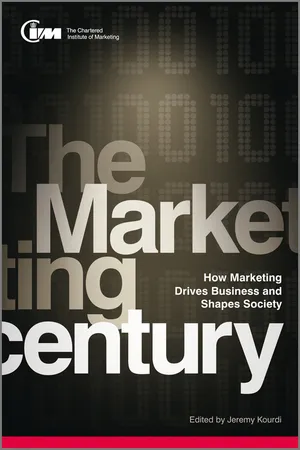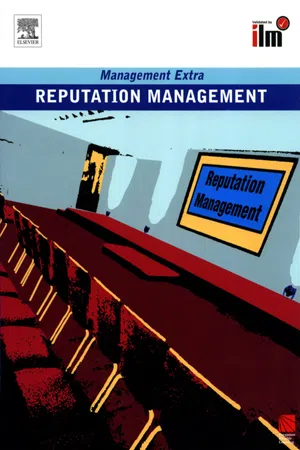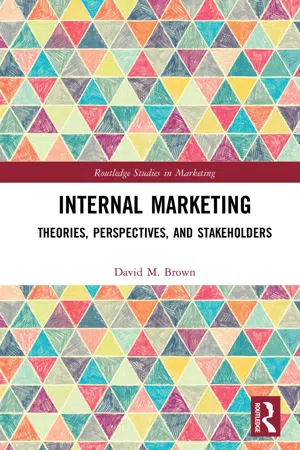Marketing
Internal Marketing
Internal marketing involves the promotion of a company's values, goals, and brand identity to its own employees. The aim is to align the internal culture and employee behavior with the company's external marketing efforts, ultimately enhancing customer satisfaction and loyalty. This approach recognizes the crucial role of employees as brand ambassadors and advocates within the organization.
Written by Perlego with AI-assistance
Related key terms
1 of 5
12 Key excerpts on "Internal Marketing"
- eBook - ePub
Marketing Communication
A Critical Introduction
- Richard Varey(Author)
- 2002(Publication Date)
- Routledge(Publisher)
The formulation and coordination of internal and external marketing plans is necessary, with the effective application of the former providing a bridge between the formulation and implementation of the latter by creating knowledge, understanding, involvement and consensus for marketing strategy and plans. Ballantyne (1991) in particular has highlighted the need for marketers to influence and motivate staff to change collaboratively the internal processes required for the effective implementation of marketing plans. Internal Marketing is the overlap between marketing management and human resource management. The changes required for good service can be facilitated if employees see the corporation as their customers see it. This in turn leads to marketing strategy having increased impact on corporate strategy as a marketing orientation and marketing capability is developed throughout the corporation. However, marketing is often seen from too narrow a perspective and it is necessary to market the marketing concept, function, and the necessary change. Problems can arise from employees’ attitudes towards the essential purposes of marketing. Morgan (1991) has suggested that strategic Internal Marketing can effect incremental culture change towards market responsiveness, i.e. operationalize the marketing of marketing and a marketing orientation. Mercer (1992) has also highlighted the marketer's role as a change agent. Internal Marketing is continuous training to enhance the service providers’ knowledge of their services and capabilities, their awareness of market opportunities and their marketing skills. The mobilization of corporate knowledge as an inimitable customer-value creator.Marketing planning must take account of organizational culture by considering it equivalent to consumer lifestyles. Then employees can be given specific attractive guidelines and incentives that promote a system of strongly held and shared values which emphasize customer consciousness and quality. We need to consider the role, involvement and influence of marketing, training, and even some personnel and recruitment matters. These are areas which have a bearing on, or direct contact with, the market and therefore, in effect, are part of the product. - eBook - ePub
The Marketing Century
How Marketing Drives Business and Shapes Society
- Jeremy Kourdi(Author)
- 2011(Publication Date)
- Wiley(Publisher)
At first glance, because the phrase ‘Internal Marketing’ contains the word ‘marketing’, it is easily assumed that in its entirety Internal Marketing must, and should, be the sole domain of the marketing function. In practice, the term ‘Internal Marketing’ tends to be used as a convenient shorthand label for aspects of marketing activity that are not customer or market facing. In other words, Internal Marketing is viewed as those activities undertaken by the marketing function inside the organisation. That, in the main, involves the marketing function forming relationships with key internal stakeholders. The priority is to gain greater internal influence as well as commitment to marketing initiatives, such as product development and campaigns, from interested groups of employees. However, it is difficult to be more specific than this about how precisely marketing professionals define and deploy Internal Marketing in practice, as this tends to vary between organisations.So, is this broad popular perception of the meaning of Internal Marketing, and its associated activities, what was meant theoretically at its inception? Does this view fit with the role that has developed through three decades of research and theoretical development? An extensive array of theory and research is present in academic literature; however, in broad terms, Internal Marketing has evolved through three linked but distinct stages of development (Table 10.1 ):1. The internal market – employee satisfaction leads to customer satisfaction 2. Part-time marketers – service-minded and customer-orientated employees 3. Internal market orientation – internal fit with the marketing strategy.The internal market – employee satisfaction leads to customer satisfaction
At its inception in the late 1970s, Internal Marketing was founded on the need for service organisations to consistently deliver high levels of service quality to customers, by better understanding the needs of employees who delivered the service. The assumption was that satisfying the needs of service employees increases job satisfaction, which in turn improves service quality. Therefore, conceptually, Internal Marketing is concerned with making available internal products (jobs) that satisfy the needs of a market (employees), while also satisfying the objectives of the organisation.In operational terms, Internal Marketing contains two central principles. First, it is important to satisfy employees’ needs before the company can satisfy the needs of its customers (Berry, 1981). Second, the rules that apply to a company’s external markets are also relevant to its internal market. In its application, Internal Marketing is an approach to service management concerned with HR and operational practice, and concerned with recruiting, training, motivating and retaining suitable service employees. The role of the marketing function at this stage of development is limited. - eBook - ePub
Communication in Organizational Environments
Functions, Determinants and Areas of Influence
- Anna Rogala, Sylwester Bialowas(Authors)
- 2016(Publication Date)
- Palgrave Macmillan(Publisher)
implementation of specific corporate or functional strategies.Actions taken within the above-mentioned areas help to develop the engagement of employees and their confidence in the organization. The tasks performed with the help of Internal Marketing include the following (Baruk 2008 , p. 85):- creating a positive image of the company among the personnel;
- developing employees awareness of the strategy and mission of the company;
- stimulating innovativeness and creativity;
- improving horizontal and vertical communication among employees;
- motivating staff.
Such a broad spectrum of activities requires the use of a broad range of instruments. A key condition for success is an efficient use of the internal communication system, which makes it possible to gain the goodwill of the staff towards the decisions taken by the management as well as developing their sense of identification with the company.The second marketing concept which puts employees at the centre of attention is personnel marketing. It includes activities conducted by a company within the social system, the aim of which is to create and maintain the image of the company as a good employer. The recipients are employees, both current and prospective, and each of the two sub-systems consists of different components. Internal personnel marketing comprises internal communication, a motivation system, and a training system for creating and reinforcing the company’s image as an employer, as well as a system of internal recruitment and selection. External personnel marketing, in turn, involves activities related to communication and recruitment, as well as creating and consolidating an organization’s external image (Baruk 2006 - eBook - ePub
Trends in Asia Pacific Business and Management Research
Relevance and Use of Literature Reviews
- Chris Rowley, Justin Paul, Chris Rowley, Justin Paul(Authors)
- 2022(Publication Date)
- Routledge(Publisher)
Ieong and Lam 2015 ; Kim, Song, and Lee 2016).4.1.2. Internal Marketing and customer-related benefits
Internal Marketing originated in the service context as a means of improving service quality for customers. Service is a human factor, thus it must be nurtured through internal systems of the organization that satisfy, motivate, and train employees to become customer-conscious and to increase the level of service quality. Positive employee outcomes translate into positive customer outcomes. Berry signifies Internal Marketing as a means to an end; that is, effective Internal Marketing is essential for effective external marketing (Berry 1981 ). Therefore, to establish a long-term relationship with its customers, the organization must focus on constructive relationships with its internal employees, as high turnover transforms into high churn rates. Conceptual and empirical research has strongly emphasized the relevance of Internal Marketing for customer satisfaction, customer service quality (Boukis et al. 2015 ; Richardson and Robinson 1986 ), and market orientation (Domínguez-Falcón, Martín-Santana, and De Saá-Pérez 2017).4.1.3. Internal Marketing and organization-related benefits
Ballantyne (2000 , 2003) states that Internal Marketing practices are the means by which knowledge can be shared, challenged, and renewed. The theory of Internal Marketing draws strong connections between learning activity and knowledge management. Internal Marketing creates a series of motivating activities to derive knowledge from individual tacit levels to the group-wide explicit level (Hume and Hume 2015 ). Internal communication and training have emerged as capable vehicles for knowledge acquisition and retention (Yang 2015 ). Training provides employees with the opportunity to learn; and as individuals learn, they create knowledge that transforms them from touch labour to knowledge workers. These knowledge workers form the foundation for organization-level learning and knowledge accumulation (Youndt and Snell 2004 ). Under the umbrella of Internal Marketing, cross-functional coordination and collaboration create the opportunity for the flow of information, tapping into experience-based individual knowledge from varied resources (Ballantyne 2003 ). This access to job-related knowledge helps employees to meritoriously perform their jobs and ensures that organizational strategies are effectively implemented in the organization. Lee and Chen (2005 ) found that Internal Marketing significantly affects knowledge management in high-tech industry in Taiwan (Lee and Chen 2005 ). Yang (2015 ), in an empirical study, found that the promotion component of Internal Marketing leads to knowledge-sharing that significantly influences organizational effectiveness (Yang 2015 - eBook - ePub
Customer Experience Management for Water Utilities
Marketing urban water supply
- Peter Prevos(Author)
- 2017(Publication Date)
- IWA Publishing(Publisher)
© IWA Publishing 2018. Customer Experience Management for Water Utilities: Marketing Urban Water Supply Peter Prevosdoi: 10.2166/9781780408675_077Chapter 4 Internal MarketingAbout twenty years ago, a realisation developed that the disciplines of management and marketing needed to be integrated in order to achieve superior service (Daniel, 1998). This realisation led to the development of Internal Marketing which is a ‘philosophy of valuing and treating employees as an intermediate set of customers inside the firm and enhancing the value provided to employees with the aim of encouraging them to enact the organisation’s marketing objectives’ (Lings & Greenley, 2010).If marketing is interpreted as the process of meeting the needs and wants of customers and providing positive experiences, then Internal Marketing can be best described as the process of meeting the needs and wants of employees and delivering positive experiences for them. Internal Marketing is the best way to help employees to create an emotional connection to the service they provide, beyond their technical involvement (Mitchell, 2002). The purpose of Internal Marketing is to minimise the gap between the customer value proposition and the employee value proposition, shown in Figure 3.1 . Internal Marketing aligns with the axioms of Service-Dominant Logic (S-D Logic) as value is co-created between the customer and the organisation. For co-creation to occur, employees need to understand the needs and wants of the consumers. They need to empathise with the experience that the customer has when consuming the service.The marketing triangle shown in Figure 4.1 visualises the relationship between the various types of marketing activities. The relationship between management and customers sets the value proposition and is referred to as external marketing. This requires management to understand the value that customers seek from the organisation, as described in Chapter three - eBook - ePub
Internal Marketing
Another Approach to Marketing for Growth
- Tatsuya Kimura(Author)
- 2017(Publication Date)
- Routledge(Publisher)
strategy of shaping job-products to fit human needs.(p. 151) Behind this argument lies the idea that the HR department is fundamentally different from departments that are expected to be responsible for the production of tangible goods.The role of marketing is to generate value by increasing customers’ utility and satisfying their needs. The HR department has a similar role: It increases customers’ utility by managing human resources in accordance with the goals of the entire firm. One of today’s marketing-related concepts is that the entire firm should be structured with customers at its core in order to properly satisfy their needs.Collins and Payne (1991) apply the marketing concept to managers of the HR department and point out three conditions that they should meet. First, HR managers must thoroughly know the needs, wants, and problems of their customers, that is, the CEO, other managers, and employees. Second, HR managers must pay attention to details in planning their department projects, making sure that coordination with other departments is achieved in terms of cost, design, and implementation and follow-up processes. Third, HR managers must halt their department’s activities that are not beneficial to the entire firm.As discussed here, there is room for the HR department to extend its role, to regard the inside of the firm as a market, and to engage in marketing. In an operational sense, Internal Marketing concerns how to coordinate the HR department and other departments so that marketing activities for the external market (i.e., the firm’s general marketing activities) can be conducted effectively. In a strategic sense, the main purpose of Internal Marketing is to motivate employees to adopt a customer orientation.The duties of HR managers are considered more difficult than those of marketing managers. This is because the outcome of HR managers’ work cannot be easily quantified and they are not responsible for final results. Yet, in some sense, they are accountable for profit results. In other words, they cannot avoid being subject to criticisms from managers of other departments who are responsible for quantifiable results, including profit results. - eBook - PDF
- Mr Ned Potter(Author)
- 2012(Publication Date)
- Facet Publishing(Publisher)
CHAPTER 9 Internal Marketing This chapter covers two related aspects of marketing which are increasingly important in libraries, but have not been discussed or written about often enough: marketing to internal stakeholders, and marketing with internal stakeholders. The importance of Internal Marketing Internal Marketing really means promoting the value of the library to the wider organization in which it sits, be that local authority, business, or university. An internal stakeholder can be defined as an individual or group with a legitimate investment in the success or otherwise of the library; an external stakeholder would usually be the customer. Unlike the customer, however, someone with a contractual or economic interest in the library may both seek to influence the marketing process, and be a market themselves. In my view, the importance of marketing to internal stakeholders is massively undervalued in the library community – I see it as an essential use of our time. These people hold the purse-strings for our libraries, and it is they who can wield the axe in tough economic times; the aim should be to market ourselves so well to them that the need to promote a campaign among our users to ‘save our library’ never arises. Because, whilst the users are absolutely essential, they don’t ultimately decide whether or not to invest money into the library service (although they can certainly help persuade those that do). Rosemary Stamp, a marketing consultant who works closely with libraries, provides an expert view on communicating messages to an internal audience in the first case study of this chapter. Another use for marketing to internal stakeholders is to be allowed to generate forward-thinking initiatives. We need to be promoting our successes to our bosses in language they understand – particularly if our bosses are not librarians – in order to secure a mandate to innovate. Andy Priestner of Cambridge University provides a case study on this subject. - eBook - PDF
Service Management and Marketing
Managing the Service Profit Logic
- Christian Gronroos(Author)
- 2016(Publication Date)
- Wiley(Publisher)
They are part-time marketers as well, although their customers are internal and not external. In summary, the four main target groups for Internal Marketing are: 1. Top management. 2. Middle management and supervisors. 3. Customer contact personnel. 4. Support personnel. It should be noted that the same person may occupy several positions. A support person may some- times be a contact person. A supervisor who, for example, is supposed to support and encourage contact people may be a contact person serving customers, or a support person serving internal cus- tomers, regularly or occasionally. Middle or top management may also have customer contacts. When they have such contacts they, too, are part-time marketers in the firm’s marketing process. STRATEGIC AND TACTICAL Internal Marketing As Internal Marketing is part of strategic management, and therefore should be a management philos- ophy, implementing Internal Marketing includes strategic aspects as well as tactical ones. On a strategic level Internal Marketing requires that management creates a job environment which is encouraging and motivating for customer-focused and service-minded behaviour. 21 On a tactical level, internal 420 PEOPLE MANAGEMENT marketing activities which aim at implementing a customer-focused, service-minded behaviour are planned and executed. STRATEGIC Internal Marketing In order for management to create a motivating and encouraging environment for service-oriented and customer-focused behaviour, four management areas are important. These are: 1. Motivating leadership and management support. 2. Motivating human resource policy. 3. Motivating training policy. 4. Motivating planning systems. In the following sections we shall discuss these in some detail. M O T I VAT I N G L E A D E R S H I P A N D M A N A G E M E N T S U P P O RT Training is an important Internal Marketing activity. However, no training programme alone is enough in an Internal Marketing process. - eBook - ePub
Reputation Management
Revised Edition
- Elearn(Author)
- 2009(Publication Date)
- Routledge(Publisher)
Improves the organisation's survival chances by improving competitive positionTable 4.1 Internal versus external marketingSince marketing is concerned with the management of exchanges, it seems sensible to assume that Internal Marketing is about the management of internal exchanges – exchanges that happen within the organisation. These exchanges are numerous and may also be hierarchical. A possible hierarchy is as follows:exchange of time for salaryexchange of loyalty for supportive managementexchange of effort for respectexchange of commitment and ideas for information about the organisation's future direction.Unlike most external marketing, the exchanges cannot always be expressly stated. While the exchange of time for salary (the basic exchange in all employment contracts) is expressly stated and is quantifiable, the other exchanges are harder to define. Having said that, the problem can still be analysed and ultimately solved.In some cases, the exchange of money for time might be as far as either party wishes to take the relationship. This situation will only arise where employees perform low-grade manual tasks and have little contact with the organisation's customers. In all other cases, employee motivation and attitudes have considerable impact on the success of the organisation. Employees are important in two ways: firstly as stakeholders in the organisation, which means that their motivation and commitment is necessary for the organisation's success; and secondly as ambassadors for the organisation.Creating pride in the organisation and in its work can be achieved by carrying out the tasks shown in Table 4.2 . These factors were identified as a result of research carried out by Kanter (1985) over a five-year period.TaskRationale and methods of achievementEncourage an atmosphere of pride Highlight the achievements of individuals, publicising these to others. Use innovative staff as agents of change - eBook - PDF
Strategic International Marketing
An Advanced Perspective
- T C Melewar, Suraksha Gupta(Authors)
- 2017(Publication Date)
- Red Globe Press(Publisher)
Without denying the importance of HRM, we still believe that the concept of Internal Marketing is strongly needed, since it emphasizes the importance of reciprocity between organizations and their members. Internal Marketing can be regarded as an EMPLOYEE DEVELOPMENT IN THE INTERNATIONAL ARENA 165 overlap between marketing and HRM, and thus further cooperation between both disciplines is strongly needed, especially in the context of international marketing. Issues for further discussion 1. The data presented show that organizations serving international markets tend to use methods for managerial development to a lesser extent. What could be the reasons for this situation? 2. If you were a member of an international team selecting candidates for the position of marketing manager, which selection criteria would you recommend? 3. What could be the consequences for the organization of not using methods to stimulate learning? Think about its internal and external environment. 4. What, in your opinion, are the obstacles that prevent the Internal Marketing concept from reaching its full potential? 5. What is the relationship between internal and external marketing in the interna- tional business context? 6. What is your opinion on the importance of Internal Marketing and its relation to marketing and HRM? CASE STUDY The development of HR in an international retail chain The Mercator Group is one of the largest and most successful commercial chains in southeastern Europe; it is the leading commercial chain in Slovenia and is rapidly becoming an established chain in the markets of Serbia, Croatia, and Bosnia and Herzegovina. In 2005, it entered the Macedonian market. These are all fast-growing markets, where it builds shopping malls in capi- tals and regional centres with the largest potential in terms of the number of residents and purchasing power. - eBook - ePub
Internal Marketing
Theories, Perspectives, and Stakeholders
- David M. Brown(Author)
- 2020(Publication Date)
- Routledge(Publisher)
When Dunmore (2005) declared Employer Branding the dominant component of IM in the attraction, retention, and development of valuable staff, this was consistent with a broader theoretical development. Several researchers had noted the propensity of positive Brand Image to contribute towards commercial success, especially in the case of brands constructed not around salient products but upon stakeholder perceptions derived from its internally and externally directed organisational actions (Kasper, van Helsingden & Gabbott, 2006). Keller (2009) asserted that those organisations enjoying the greatest brand equity invariably shape their external marketing strategies around internal market considerations – a suggestion seemingly approving of internal stakeholder primacy. As Brand Image is derived from symbolism and perceptions (Low & Lamb, 2000), and it represents organisational attributes, customer attitudes, and stakeholder benefits (Aaker, 1996; Keller, 2009), IM professionals should adopt those dimensions of Brand Identity which are likely to be most resonant with internal customers, in the same way that marketers have external customers (Aaker, 1996). The twelve proposed dimensions were clustered within four perspectives reflecting whether staff perceived the brand as a product, organisation, person, or symbol. Other researchers who have focused less on brand have instead analysed the interconnected nature of IM, relationship building, and internal communication (e.g. Oliver, 1997; Kitchen, 2005), seeing IM as a way to communicate information appertaining to organisational affairs (Grunig, 1992) or to facilitate interpersonal employee communication (Argenti, 1998). Ballantyne (2000) considered IM as a vehicle capable of establishing internal relationships and refreshing organisational knowledge but, like almost all researchers in this field, found IM to be a rich blend of strategies and concepts which could be approached from a variety of theoretical perspectives (Kelemen & Papasolomou-Doukakis, 2004).2.4 The aims and potential of Internal Marketing
As we have seen, the potential remits intended for IM vary greatly in scope from one theorist to another, but all anticipate an ambitious role which delivers a range of benefits to the organisation, its employees, and customers. The greatest tension within the literature surrounds theorists’ prioritisation of those three entities, and this consideration has influenced how authors have perceived the aims of IM. Berry & Parasuraman (1991) described IM as a three-stage process in which employees are enlivened and motivated by treating them as customers and then both employees and ‘the organisation’ (i.e. also at the level of strategic direction and management) are reoriented towards external customers, and finally strategies are implemented to manage change and bring about improvements to performance. Whilst this took a more holistic view to IM than most research, which tended to isolate one single phase of IM for examination, its eventual scrutiny of commercial and external customer benefits reflects the dominant form of stakeholder prioritisation in the academic debate. - eBook - ePub
Branding Inside Out
Internal Branding in Theory and Practice
- Nicholas Ind(Author)
- 2017(Publication Date)
- Kogan Page(Publisher)
11Internal brand management: employees as a target group for brand management
CHRISTOPH BURMANN AND RICO PIEHLERRelevance of internal brand management
Brand management has mainly been applied to external stakeholders, such as customers, but the admittedly important development of, and communication about, the brand promise externally really represents only one side of the coin (Ind, 2003). The other side is the fulfilment of the brand promise, because only when customers experience this do they achieve satisfaction, brand trust, and stronger brand– customer relationships (Delgado-Ballester et al. , 2003; Burmann and Zeplin, 2005; Piehler et al. , 2015). As employees are directly or indirectly responsible for the fulfilment of the brand promise, so they represent an important, internal target for brand management efforts (Harris and de Chernatony, 2001; Mitchell, 2002; Ind, 2003). Consequently, as brand management research and practice has expanded in the past 15 years to include internal stakeholders such as employees, so internal brand management, or internal branding, has developed in organizational initiatives that address employees from a brand management perspective (Piehler et al. , 2016). The growing recognition that employees are a key source of sustainable differentiation and competitive advantage in markets for increasingly similar products and services (Mosley, 2007) means the relevance of internal brand management can only grow.Current state of research
Piehler et al. (2015) define internal brand management (IBM) as a concept that implements the brand cognitively, affectively, and behaviourally at the employee level. This important management concept involves not just frontline employees but all employees in the organization. Customer-facing employees shape customers’ experience of the brand directly, through their actions at brand touch points. Consequently, the relevance of IBM may be greater when employees are more prominently involved in the delivery of products and services, interact more directly with customers, or are more diverse. Those employees who do not face customers directly (eg R&D scientists, members of the manufacturing department) still shape the brand experience indirectly through their role as internal suppliers to customer-facing employees (eg responsible for product and service quality). A similar logic for an expanded view of IBM applies across hierarchical levels: IBM does not only represent an important management concept for employees in entry-level positions. Supervisors and managers contribute to the fulfilment of the brand promise through their brand-oriented leadership and implementation of structures and processes that support employees in entry-level positions (Piehler et al.
Index pages curate the most relevant extracts from our library of academic textbooks. They’ve been created using an in-house natural language model (NLM), each adding context and meaning to key research topics.











